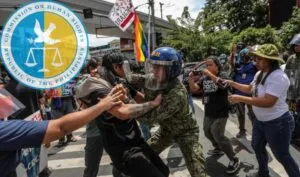Few federal agencies spark as much curiosity, controversy, and confusion as ICE. Short for U.S. Immigration and Customs Enforcement , it operates inside the Department of Homeland Security (DHS) and carries one of the broadest portfolios in American law enforcement.
It’s not the Border Patrol, though many assume it is. ICE works mainly beyond the border: in cities, workplaces, airports, detention centers, and digital systems, handling interior immigration enforcement and cross-border crime that reaches deep into the United States.
Here, we’ll break down what ICE actually does, how it’s structured, and what its work means for communities, businesses, and the broader immigration system.
Table of Contents
ToggleA Quick Look
| Aspect | Description |
| Agency | U.S. Immigration and Customs Enforcement (ICE) |
| Parent Department | Department of Homeland Security (DHS) |
| Main Roles | Interior immigration enforcement and transnational criminal investigations |
| Key Divisions | Homeland Security Investigations (HSI) and Enforcement and Removal Operations (ERO) |
| Supporting Offices | Office of the Principal Legal Advisor (OPLA) and Office of Professional Responsibility (OPR) |
| Legal Basis | Immigration and Nationality Act (INA) for civil enforcement, plus a wide range of federal criminal statutes |
| Scope | Operates through hundreds of U.S. offices and international postings |
How ICE Is Structured
ICE has two main operational arms and two major support offices. Together, they cover everything from cybercrime to deportation logistics.
1. Homeland Security Investigations (HSI)
HSI is the investigative powerhouse of ICE, essentially a federal detective service focused on transnational threats. Its agents don’t just work on immigration.
They investigate complex criminal networks that touch national security, commerce, and public safety.
HSI focuses on:
- Human smuggling and trafficking networks that exploit people across borders.
- Child sexual exploitation and darknet marketplaces that trade in illegal content.
- Drug trafficking, including fentanyl and precursor chemicals moving through global supply chains.
- Weapons trafficking and export-control violations involving restricted technologies.
- Sanctions evasion and trade-based financial crime.
- Intellectual-property theft and counterfeit goods that endanger consumers and businesses.
- Cyber-enabled crime that affects critical systems and crosses borders.
HSI agents may work months or even years tracing illicit money flows, running undercover operations, or coordinating with foreign police to dismantle global cartels. Their cases often end up in federal court with U.S. Attorneys as partners.
The agency’s footprint spans more than 200 U.S. offices and dozens of international posts supporting investigations worldwide.
2. Enforcement and Removal Operations (ERO)
ERO handles civil immigration enforcement inside the U.S. Once someone is subject to arrest or removal under immigration law, ERO steps in.
Its responsibilities include:
- Identification and arrest of people who may be removable under the Immigration and Nationality Act.
- Detention management , including oversight of facilities that must meet ICE’s Performance-Based National Detention Standards (PBNDS).
- Alternatives to Detention (ATD) programs, which use monitoring and case management for people not held in custody.
- Removal logistics , coordinating flights and ground transport to repatriate people to their countries after due process.
Public data dashboards show ERO’s activity in real numbers: arrests, detention levels, removals, and ATD enrollments. Also, arrests in red states more likely occur in jails or prisons, while in blue states, more arrests happen in the community.
In late 2024, ICE reported an uptick in removals compared to previous quarters, continuing a rising trend into fiscal year 2025.
3. Office of the Principal Legal Advisor (OPLA)
OPLA is DHS’s largest legal program. Its attorneys represent the government in immigration court, handle litigation, and advise ICE personnel on legal questions.
Immigration courts are civil, not criminal, so OPLA lawyers prosecute cases before the Executive Office for Immigration Review (EOIR).
They also issue legal guidance to field offices, shaping enforcement priorities and how certain cases are handled.
4. Office of Professional Responsibility (OPR)
Integrity and accountability fall to OPR . It investigates misconduct within ICE, handles complaints, and coordinates with oversight bodies like the DHS Office of Inspector General (OIG).
OPR’s role ensures that operations and personnel follow federal law, policy, and ethical standards.
What Laws and Powers ICE Uses
ICE draws authority from two major legal areas:
- Civil immigration enforcement under the Immigration and Nationality Act (INA).
- Federal criminal statutes that cover smuggling, money laundering, trafficking, sanctions, and more.
In practice, that means:
- HSI investigates crimes that cross borders or involve trade, finance, or national security.
- ERO enforces civil immigration law, making administrative arrests and managing detention or ATD programs.
Congressional research separates responsibilities among DHS components:
- CBP handles border security.
- ICE manages interior enforcement and criminal investigations.
- USCIS processes immigration benefits like green cards and naturalization.
That separation defines where ICE’s authority begins and ends.
Day-to-Day Work at ICE
ICE’s daily work stretches far beyond headlines. Its agents and officers tackle everything from cybercrime investigations to immigration enforcement, operating in offices, detention centers, and courtrooms across the country.
Criminal Investigations (HSI)
HSI agents handle some of the most intricate criminal cases in federal law enforcement. They might:
- Trace illegal financial networks that move laundered money through shell companies.
- Infiltrate smuggling rings or intercept illicit shipments.
- Investigate darknet operations selling stolen data or illegal materials.
- Work with foreign governments to take down global criminal organizations.
Their tools range from undercover work to forensic accounting and advanced cyber analysis. HSI also collaborates with Interpol, Europol, and partner nations through international offices.
Civil Enforcement (ERO)
ERO’s work is administrative but deeply consequential. Once someone is found removable under immigration law, ERO decides how to proceed.
Key Functions
- Arrest and processing: Using administrative warrants, officers take individuals into custody for immigration violations.
- Detention operations: Facilities must comply with the PBNDS 2011 (updated in 2016), which outline safety, health care, and access to counsel.
- Alternatives to Detention (ATD): For lower-risk individuals, ICE can use check-ins, GPS monitoring, or case management instead of physical detention.
- Removal coordination: ERO manages the travel logistics, working with foreign governments for repatriation.
HSI vs. ERO at a Glance
| Area | HSI | ERO |
| Core mission | Criminal investigations tied to cross-border crime | Civil immigration enforcement |
| Work type | Undercover ops, digital forensics, export-control and trafficking cases | Arrests, detention, alternatives, and removals |
| Legal framework | Federal criminal law | Civil immigration law (INA) |
| Output | Seizures, indictments, dismantled networks | Interior arrests, removals, ATD data |
Detention, Standards, and Alternatives
Detention is one of ICE’s most visible and debated roles. It covers not just holding facilities, but also the rules that govern them and the alternatives that let some people remain in the community while their cases move forward.
Detention Standards
ICE’s Performance-Based National Detention Standards (PBNDS) set the baseline for how detention facilities operate. The 2011 edition, updated in 2016, includes detailed rules for:
- Medical and mental health care
- Grievance procedures and oversight
- Access to legal counsel
- Recreation, visitation, and safety
Alternatives to Detention (ATD)
Not everyone in removal proceedings is detained. ATD programs allow people to remain in the community while their case progresses.
They may include:
- Regular check-ins with case managers
- Electronic monitoring (ankle bracelets or apps)
- Support services to ensure appearance in court
According to DHS materials, ATD programs are intended to balance enforcement with humanitarian considerations. Privacy assessments, cost analyses, and contractor oversight reports are publicly available, reflecting how closely the programs are monitored.
Advocacy groups continue to debate ATD’s impact , with some arguing it reduces detention costs while others highlight privacy and mental health concerns.
What the Numbers Show

ICE’s activity levels fluctuate with policy changes, funding, and migration patterns.
Enforcement Trends
Recent DHS and ICE updates indicate:
- Higher removals in late 2024 compared to previous quarters.
- Rising detention populations linked to shifting priorities.
- More ATD participants , reflecting a growing reliance on technology-based monitoring.
Those figures are influenced by court rulings, foreign government cooperation, and domestic policy shifts.
Budget and Staffing
The DHS FY 2025 budget continues to allocate billions to ICE for personnel, transportation, and detention operations. Congressional hearings have focused on balancing funds between criminal investigations (HSI) and immigration enforcement (ERO).
Independent analysts often track how budget changes affect staffing levels and detention capacity.
Counterfeit and Trade Enforcement
HSI also plays a significant role in protecting U.S. businesses from counterfeit goods. DHS’s open data shows billions in seized fake items each year: everything from electronics to pharmaceuticals. Those seizures help safeguard consumers and intellectual property.
ICE Within DHS
It’s easy to mix up DHS’s many parts. Here’s the simplest way to keep them clear:
| Agency | Core Role |
| CBP | Manages border crossings and ports of entry |
| ICE | Handles interior immigration enforcement and transnational investigations |
| USCIS | Administers benefits like green cards, asylum, and naturalization |
So, ICE doesn’t patrol the border; it works beyond it, focusing on the enforcement and investigative side of immigration.
Oversight, Accountability, and Legal Process
Oversight keeps ICE’s vast authority in check. From internal investigations to congressional scrutiny, multiple layers monitor how the agency enforces laws, manages detention, and handles misconduct.
OPLA in Immigration Court
OPLA’s attorneys represent the government before the Executive Office for Immigration Review.
They present cases, negotiate outcomes, and advise on prosecutorial discretion. Because immigration courts are civil, not criminal, cases often hinge on administrative law and relief eligibility.
OPR and External Oversight
OPR ensures accountability within ICE by investigating misconduct and maintaining ethics programs. Oversight also comes from:
- DHS Office of Inspector General (OIG)
- Congressional committees
- Federal courts and watchdog groups
Their reports influence how detention facilities operate and how enforcement policies evolve.
Detention Standards in Practice
PBNDS sets the rules, but ensuring compliance is an ongoing challenge. DHS periodically issues updates and corrective plans after inspections.
Advocacy organizations continue to document inconsistencies, especially around medical care, access to counsel, and facility conditions.
Recent Developments
- Activity growth: ICE reported a significant increase in removals in late 2024.
- Leadership focus: HSI has expanded emphasis on transnational organized crime, child protection, and export-control enforcement.
- Budget scrutiny: Congressional committees continue to debate ICE’s funding for detention and investigative priorities.
Public debate often centers on whether ICE’s resources should tilt more toward complex criminal investigations or toward immigration enforcement.
Common Misconceptions
- “ICE is the Border Patrol.” – No, ICE operates mainly in the interior. The Border Patrol is part of CBP.
- “HSI and ERO do the same work.” – HSI handles criminal investigations; ERO manages civil immigration enforcement. Different laws, different courts.
- “Detention standards are only on paper.” – They are formalized and revised, but enforcement varies. Oversight agencies and lawsuits regularly push ICE to meet those standards.
Why ICE Matters
ICE’s work affects multiple layers of society.
Businesses
- HSI enforces export controls, trade sanctions, and intellectual-property rights.
- Worksite investigations target employers who violate immigration or labor laws.
- Counterfeit goods seizures protect legitimate companies and consumers.
Communities
- ERO’s arrests, detention decisions, and removals directly touch families and local organizations.
- Nonprofits and local governments provide legal aid and housing support to those in proceedings.
Travelers and Students
- HSI protects against identity theft, document fraud, and smuggling that could undermine visa programs.
- ERO may become involved if someone overstays or violates the terms of a visa after entering the country.
Major Criticisms and Controversies Around ICE
ICE’s work has long been shadowed by controversy. From detention conditions to surveillance practices, the agency’s actions have sparked ongoing public debate, lawsuits, and calls for stronger oversight.
1. Detention Conditions, Oversight Failures, and Recordkeeping Issues
One recurring criticism of ICE involves the treatment of people in its custody and the gaps in oversight.
- A policy brief from the Immigrant Justice Project describes ICE’s oversight as “abusive,” arguing the agency fails to meaningfully inspect facilities, allowing abuses to persist under the radar.
- The American Immigration Council found that ICE often does not maintain adequate records concerning detainee treatment. That lack of proper recordkeeping contributes to impunity and makes legal accountability harder.
- During the COVID-19 pandemic, multiple reports noted that detainees experienced medical neglect, unsafe conditions, and neglect of basic needs.
In effect, critics argue that ICE’s formal standards (like its Performance-Based National Detention Standards) exist on paper, but enforcement is inconsistent; oversight bodies and courts frequently point out discrepancies.
2. Worksite Raids, 287(g) Agreements, and Local Cooperation Issues
ICE’s enforcement in workplaces and local law enforcement agreements has also drawn protest.
- The Southeastern Provisions raid (also called the Bean Station, TN raid in 2018) is often cited as one of the largest ICE workplace enforcement operations. Dozens of workers were arrested, sparking lawsuits and community backlash.
- According to the Center for American Progress , the 287(g) program allows local police to partner formally with ICE and enforce immigration laws. Critics warn that such blending of local policing and deportation authority erodes civil liberties and local trust. Center for American Progress+1
- A recent article from the ACLU argued that expanding 287(g) arrangements risks turning local police into “deportation agents” and amplifying abuses.
3. Racial Profiling and Discrimination
Race, ethnicity, and national origin frequently lie at the heart of criticism against ICE’s practices.
- After aggressive ICE raids in Los Angeles during 2025, federal judges found elements of racial profiling in how operations were conducted.
- Observers note ICE’s usage of masked agents, plainclothes operatives, and unmarked vehicles has produced public complaints of intimidation, lack of transparency, and even confusion with impersonators.
- According to the American Immigration Council , a recent Supreme Court decision raised concerns that future raids could increasingly affect lawful residents and citizens, if racial profiling slips further.
Put simply: when law enforcement actions appear tied to demographic factors rather than case assessments, trust erodes and legal challenges mount.
4. Surveillance, Espionage Tools, and Data Privacy
ICE’s use of digital surveillance tools has drawn attention and alarm from civil liberties groups.
- Reports on the ICE-Paragon contract ( Graphite spyware ) suggest ICE regained use of a phone surveillance tool that can access encrypted apps and often lacks public oversight. Critics argue that such capabilities raise serious Fourth Amendment and privacy concerns.
- Civil rights defenders argue that agencies like ICE can abuse such tools if they’re not constrained by strong checks and transparent rules.
5. Recent 2025 Operations and Legal Pushback
Controversy is hardly just historical. Recent ICE initiatives and the public reaction show how contentious the agency remains.
- Operation Midway Blitz : launched in Chicago in September 2025, this enforcement sweep targeted noncitizens with criminal records. But questions emerged around legality, planning (lack of coordination with state officials), and the anxiety it generated in Latino communities.
- In Los Angeles, ICE’s raids sparked widespread protests. Some courts ruled ICE was operating with racial bias and even ignored court orders to suspend certain tactics.
- A recent ICE ad campaign offering bonuses to local law enforcement to join mass deportation efforts also drew sharp criticism, seen by many as coercive and provocative.
- The removal of the ICEBlock app (which let users report sightings of ICE agents) from app stores under pressure from the Justice Department became a flashpoint in debates over free speech, law enforcement safety, and surveillance.
The Bottom Line
ICE isn’t a single-purpose agency. It’s a mix of investigative, legal, and enforcement arms that reach across borders and into communities. HSI fights organized crime and trafficking networks. ERO enforces immigration law in the interior. OPLA handles litigation, and OPR safeguards accountability.
Numbers rise and fall with policy, resources, and global events, but ICE’s core mission remains: to enforce U.S. immigration and customs law and investigate transnational threats that impact national security and public safety.
For anyone trying to grasp what ICE really does, the key is to separate its parts, know which laws they operate under, and keep an eye on how priorities shift year by year. That’s where the agency’s real story unfolds.
Related Posts:
- 26 Most Dangerous Cities in US - Updated Statistics for 2025
- Safest Countries in the World in 2025 - GPI…
- How Many International Airports Are There In The US in 2025?
- America's Murder Capitals: A 2025 Ranking of the…
- Capital Cities in Europe: Top Destinations For You…
- Most Dangerous Cities in Mexico 2025 - Top 10 Places…











